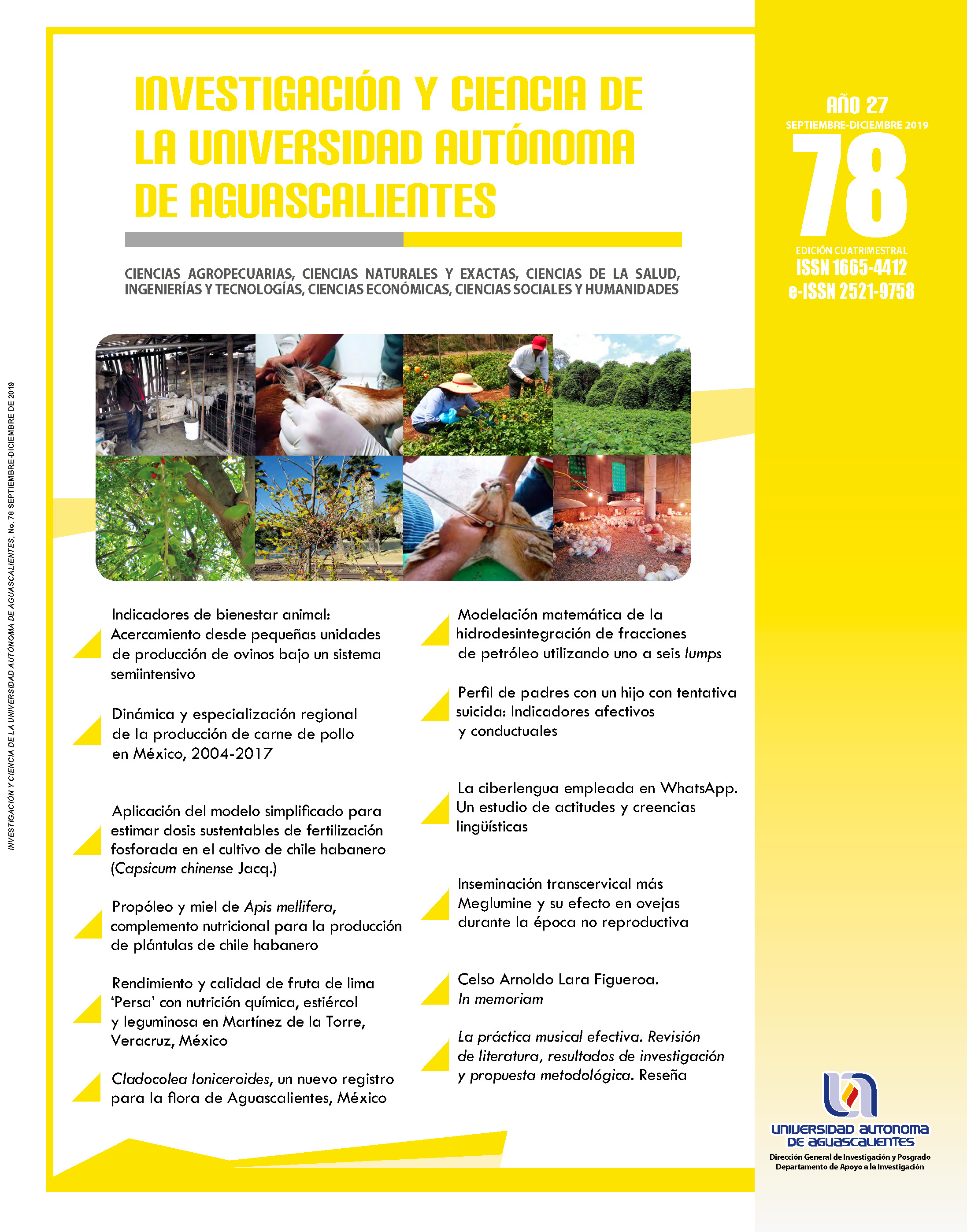Application of the simplified model to estimate sustainable doses of phosphorus fertilization in the habanero chili crop (Capsicum chinense Jacq.)
DOI:
https://doi.org/10.33064/iycuaa2019782229Keywords:
habanero chili, fertilization, phosphorus, dose, sustainability, crop yieldAbstract
Habanero chili crop is a source of income for producers on the Yucatan Peninsula. An experiment was set up in July 2017 by previously taking a soil sample of the plot, with a loamy clay texture, and applying three fertilization treatments: 56, 112 and 168 kg ha-1 of phosphorus, defined according to the management of the producers. The number and weight of the fruits and the yield were measured. In the end, we evaluate the initial and final soil and plant samples collected at each treatment on macro and micronutrient concentrations in roots, stems, leaves, and fruits. We found no significant effects of the treatments by the effect of increasing doses of phosphate fertilizers, the fruit yield ranging from 63.4 to 69.7 t ha-1. In this study, we applied the simplified conceptual model to estimate the fertilization dose that contributes to the sustainability of their management.
Downloads
References
• Avilés, W., Dzib, R., & Pereyda, G. (2010). Manual para la producción de chile habanero Capsicum chinense Jacq. en Yucatán a campo abierto y bajo estructuras de protección (Folleto Técnico No. 7). Mérida, Yucatán, México: INIFAP.
• Batjes, N. H. (2011). Global distribution of soil phosphorus retention potential (ISRIC Report 2011/06, 42 pp.). Wageningen, Holanda: ISRIC World Soil Information.
• Fideicomiso de Riesgo Compartido. (31 de mayo de 2017). Chile habanero, con denominación de origen [Blog gubernamental]. Recuperado de https://www.gob.mx/firco/articulos/chile-habanero-con-denominacion-deorigen? idiom=es.
• García, E. (1973). Modificaciones al sistema de clasificación climática de Köppen (para adaptarlo a las condiciones de la República Mexicana) (2ª. ed.). México, D.F.: Universidad Nacional Autónoma de México.
• Mahdi, S. S., Talat, M. A., Hussain Dar, M., Hamid, A., & Ahmad, L. (2012). Soil phosphorus fixation chemistry and role of phosphate solubilizing bacteria in enhancing its efficiency for sustainable cropping-A review. Journal of Pure and Applied Microbiology, 6(4): 1905-1911.
• McKean, S. J. (1993). Manual de análisis de suelos y tejido vegetal. Una guía teórica y práctica de metodologías (Documento de trabajo No. 129, 100 pp.). Cali, Colombia: Centro Internacional de Agricultura Tropical.
• Naeem, A., Akhtar, M., & Ahmad, W. (2013). Optimizing available phosphorus in calcareous soils fertilized with diammonium phosphate and phosphoric acid using Freundlich adsorption isotherm. Scientific World Journal, 680257. doi:10.1155/2013/680257
• Rodríguez, S. J. (1990). Fundamentos de fertilidad de cultivos. Santiago de Chile, Chile: Pontificia Universidad Católica de Chile.
• Secretaría de Agricultura, Ganadería, Desarrollo Rural, Pesca y Alimentación. (2015). Agenda Técnica Agrícola de Campeche (2ª. ed., ISBN 978-607-7668-42-8, 186 pp.). México: Autor.
• Servicio de Información Agroalimentaria y Pesquera (2019). [Portal electrónico gubernamental]. Recuperado de https://www.gob.mx/siap
• Sharpley, A. (2000). Phosphorus availability. En: M. E. Sumner, P. Ming Huang, & Y. Li (Eds.), Handbook of Soil Science: Properties and Processes (pp. D18-D37). New York: CRC Press.
• Tukey, J. W. (1991). The philosophy of multiple comparisons. Statistical of Science, 6(1), 100-116.
• Tun, D. J. C. (2000). Aplicación de fertilizantes a través del agua de riego a hortalizas y frutales, mediante sistemas de riego presurizado. Informe Final. Mocochá, Yucatán, México: INIFAP Campo Experimental Zona Henequenera.
• Valadez, L. A. (2001). Producción de hortalizas (9ª. ed.). México: Editorial Limusa.
• Yousaf, M., Li, J., Lu, J., Ren, T., Cong, R., Fahad, S., & Li, X. (2017). Effects of fertilization on crop production and nutrientsupplying capacity under rice-oilseed rape rotation system. Scientific Reports 7, 1270. doi: 10.1038/s41598-017-01412-0
Published
Versions
- 2019-09-30 (2)
- 2019-09-30 (1)
How to Cite
License
Copyright (c) 2019 Brenda Aremmy Ramírez-Vargas, Eugenio Carrillo-Ávila, José Jesús Obrador-Olán, Domingo Coh-Méndez, Avelardo Monsalvo- Espinosa, Everardo Aceves-Navarro

This work is licensed under a Creative Commons Attribution-NonCommercial-ShareAlike 4.0 International License.
Las obras publicadas en versión electrónica de la revista están bajo la licencia Creative Commons Atribución-NoComercial-CompartirIgual 4.0 Internacional (CC BY-NC-SA 4.0)









